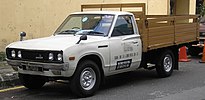Datsun Truck
| Datsun Truck | |
|---|---|
 | |
| Overview | |
| Manufacturer | Datsun Nissan |
| Production | 1955–present |
| Model years | 1956–1997 |
| Body and chassis | |
| Class | Compact pickup truck |
| Layout | Front engine, rear-wheel drive |
| Chronology | |
| Predecessor | Datsun 6147 |
| Successor | Nissan Navara |
The popular and economical Datsun/Nissan compact pickup truck was produced in Japan from 1955 and has been sold in large numbers across all continents. Modern versions of this vehicle are still in production around the world, currently with the Frontier and Navara names. In Japan, it was exclusive to Nissan Bluebird Shop locations.
Predecessors
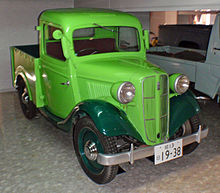
The Datsun truck line began with the Model 13 Truck of April 1934, and was later used as the basis of the Datsun DC-3 roadster. A series of small trucks based on their passenger car counterparts, the 14, 15, and 17 continued to be built until early 1944. This was followed by the near identical post-war Datsun 1121 (1946) and 2124 (1947–1949). In 1949 the 3135 took over, followed by next year's Datsun 4146. In 1951 the 5147 appeared, which was succeeded two years later by the 6147. Aside from a bigger and more modern engine (with 25 PS or 18 kW), the Datsun 6147 was nearly identical to the prewar type 15 truck. This was built until the 1955 introduction of the all new 120-series truck.
Datsun 120
| Datsun 120/220 | |
|---|---|
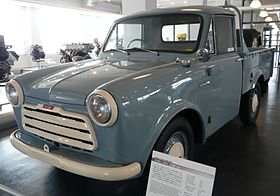 Datsun 220 | |
| Overview | |
| Production | 1955–1961 |
| Model years | 1956–1961 |
| Assembly | Nissan Shatai, Hiratsuka, Kanagawa, Japan |
| Body and chassis | |
| Body style |
|
| Layout | Front engine, rear-wheel drive |
| Related | Datsun Bluebird 210 |
| Powertrain | |
| Engine | |
| Transmission | 4-speed manual |

The Datsun 120 was a load carrying bodystyle version of the Datsun 1000 sedan (110 series), and was introduced in January 1955 as the first Datsun truck with up-to-date styling. Delivery van, panel van (120 only), and double cab versions were available. Until 1959 it used the 25 hp, 860 cc Nissan D10 engine with a four-speed floor shift (column shift for the 123 and later versions) manual transmission. During its six years in production six main models were built: 120 (Jan. to Dec. 1955), 122 (Dec. 1955 to May 1956) and 123 (Jun. 1956 to Sep. 1957). For reasons unknown, Nissan skipped the 121 designation. After the introduction of the re-engined 220-series truck, a modernized low-cost option, the Datsun 124, was introduced in October 1957. It continued to use the same bodywork and engine as the 123, although with less chrome trim.[1] This was then followed by the re-engined Datsun 125 in 1959 and finally by the Datsun 126 in 1960. While the 124 was still powered by the D10, the 125 and 126 received an improved version of this engine called the B-1, rated at 27 PS.
Datsun 220
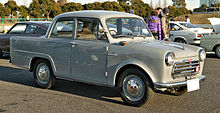
In November 1957 the type 220 was introduced. Largely unchanged in appearance from the 120-series, which continued to be built as a cheaper version, it was produced from 1957 to 1961. During this time four models were produced: 220 (1957–1958), 221 (1958–1959), 222 (1960), and 223 (1961). The chassis was based on the 210 series sedans. Two engines were available: the 37 hp Nissan C engine, and the 48 hp Nissan E engine. The E engine was originally only used in models sold on the export market. The 223 was powered by a new engine, the Nissan E-1, rated at 60 hp. The 220 was the first Datsun truck to be equipped with a 12 volt electrical system. Double cab and delivery van versions were available. Side badges were "Datsun 1000" or "Datsun 1200". The 223 also had a round "60 HP" badge. There was also a round badge on the dashboard that said "Datsun 1000" or "Datsun 1200", depending on the engine. The 223 had a revised chassis and suspension system. The front I-beam suspension used on the 220, 221 and 222 was replaced with an independent front suspension with torsion bars. A long bed version was introduced with the 222. As a low cost option, a lightly changed model of the D10 sidevalve-engined predecessor was introduced in October 1957 (the Datsun 124), followed by the Datsun 125 in 1959 and finally the Datsun 126 in 1960. The 125 and 126 were powered by the B-1, an improved version of the D10 with 27 hp.
In 1958 the Datsun 220 was exhibited at the Los Angeles Auto Show, with American exports beginning soon after. It was the 220 series that established Datsun in the American market.
Datsun 320
| Datsun 320 | |
|---|---|
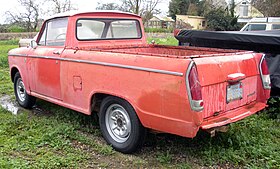 1964 Datsun NL320 | |
| Overview | |
| Production | 1961–1965 |
| Model years | 1962–1965 |
| Assembly | Nissan Shatai, Hiratsuka, Kanagawa, Japan |
| Body and chassis | |
| Body style |
|
| Layout | Front engine, rear-wheel drive |
| Related | Datsun Bluebird S310 |
| Powertrain | |
| Engine | 1.2 L E-1 I4 |
In August 1961 the new 320 series was released. It was produced until 1965 in three series (320–322). The 320 series was largely inherited from the earlier 120/220, although with clear improvements to body and frame. It used the Nissan E-1 engine. This engine produced 60 PS.
All Datsun trucks kept the A-arm torsion bar front suspension with leaf-sprung rear ends and had a 1/2 ton load capacity. Rear end gearing was a low 4.875:1 along with a four-speed transmission; as a result, the 320 was not freeway friendly above 60 mph. Fender emblems showed "Datsun 1200" and "60 HP" ("55ps" for models sold in Japan) with a "Datsun" emblem on the front nose of the hood.
Available bodystyles include a single cab "truck" (320), a longer wheelbase single cab truck (G320), a double cab "pickup" with flush sides (U320), and a three-door "light-van" (V320). Though described (and taxed) as a van in the Japanese market, the V320 is essentially a two-door station wagon. The 320 came in two cab and bed versions: Regular, and as the NL320 "Sports Pick-Up" (1963–65) variation which is a rarer (around 1,000 produced) version with the cab and bed of a one-piece design. Its back half is greatly different than that of the standard, separate bed 320 pick-up.

Bed and luggage space were in addition to the expansion, with the support of the market characteristics and the robust chassis engine was easy to handle, it was a best seller in the truck market segment.
The chassis was also a sales hit 310 in the reinforcement of the type Datsun Bluebird 310, a variation of the same series, in which the X-members plus a reinforcement of the Fairlady roadster of the S310-type CSP311. It was also used for the new Silvia coupé.
In 1964 the 320 underwent minor changes. After having adding the failed Light Stout, Toyota took over Hino's Briska and then continued with the Hilux. Mazda also competed in this segment, with the Mazda B-Series. In 1960, Nissan assumed operations of the Minsei Diesel Industries, Ltd., renaming the company as Nissan Diesel Motor Co., Ltd (now UD Trucks).
Datsun 520
| Datsun 520, 521 | |
|---|---|
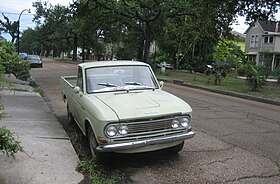 Datsun 1300 | |
| Overview | |
| Production | 1965–1972 |
| Model years | 1966–1972 |
| Assembly | Nissan Shatai, Hiratsuka, Kanagawa, Japan |
| Body and chassis | |
| Body style |
|
| Layout | Front engine, rear-wheel drive |
| Related | Nissan Bluebird 510 |
| Powertrain | |
| Engine | |
| Dimensions | |
| Wheelbase | |
The Datsun 520 was built from 1965 until 1969 (the 420 designation was skipped). It used the new 1.3 litre, 67 hp Nissan J13. In 1965 and 1966 the 520 had two single headlights. For 1967, the 520 was slightly redesigned and had twin headlights. This design was carried on until the end of 520 production. Single cab (520), LWB Single cab (G520), Double cab (U520) and delivery van (V520) versions were available. "G" was used to identify the long wheelbase versions. The fender emblems said "Datsun 1300". A grille emblem was added in 1966 and simply said "D". In late 1967 a slightly altered model appeared, now with a slightly changed chrome grille with a distinct frame.[3]
The 521 was the facelifted version of 520, with a so-called "flat-deck" style. This meant a flattened bonnet and front fenders as well as a new grille design.[2] It used the Nissan J engines (the previously mentioned J13 or the larger J15, rated at 77 hp) and later had a 95 PS (70 kW) Nissan L16 engine, always with a straight rear axle. The 520 strongly resembles a Datsun 410/411 from the front, since it shares most sheet metal with that car. The fender emblems said "Datsun 1300", "Datsun 1500" or "Datsun 1600" (depending on engine fitment). Van/delivery van (V521) and double cab (U521) versions were available. It was manufactured from 1969–1972, preceded by the 520 and followed by the 620. The 521 was the first compact half-ton pickup sold in the American market, in 1968 [citation needed].
In 1968, larger load carrying duties were now shared with the Datsun Cabstar, a cabover truck.
Datsun 620
| Datsun 620 | |
|---|---|
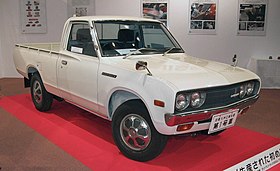 Datsun 620 | |
| Overview | |
| Also called | Yue Loong 753 (TW) |
| Production | 1972–1979 |
| Model years | 1973–1979 |
| Assembly | Nissan Shatai, Hiratsuka, Kanagawa, Japan |
| Body and chassis | |
| Class | Compact truck |
| Body style |
|
| Layout | Front engine, rear-wheel drive |
| Related | Nissan Bluebird 610 |
| Powertrain | |
| Engine | |
| Transmission | |
| Dimensions | |
| Wheelbase | |
In February 1972, the Datsun 620 truck was released and was in production until 1979. It was a regular cab truck (a longer "King Cab" version was released in 1977) and two wheelbases were offered, for a total of six different models. There was also a delivery van version, offered only in Japan. Naturally there were bare chassis models, and many importers installed locally made flat decks. There was also the U620, which is a crew cab "Utility" version. It uses a shorter, fully integrated bed to allow comfortably seating four people. The U620 was essentially a 620 pickup from the doors forward, with the bed and rear end being the only difference. Nissan continued the strong rhythms and styling of its previous vehicles, with a shoulder "wing line" or "Bullet Side" accent running alongside the vehicle. In most of the world the 620 was equipped with the J15, producing 77 hp (57 kW) and with a top speed of 135 km/h (84 mph).[5] A 2.2 liter diesel engine with 66 hp (49 kW) was later made available in many markets.
The 620 was also the first Datsun pickup truck to be available with a longer "King Cab" passenger compartment (called "Custom" in Japan). This utilized the bed from the normal 620 truck, but has a cabin stretched by 24 cm (10 in)*, all placed on the longer wheelbase.[6]
The 620 was redesigned slightly for 1978, with changes to grille and front bumper. A four-door crew cab variant was also offered in some markets.
North America
In North America, the 620 continued to use the Nissan L engine. The 1972 and 1973 models were powered by the L16 engine (96 hp), the 1974 model used the L18 engine (100 hp), and the 1975 through 1979 models used the L20B engine (110 hp SAE Gross). SAE Net rating was 97 hp (72 kW). This was a "50-state car", with an EGR system for pollution control which sufficed to meet California's stringent emissions standards without a catalytic converter.[7] The 620 was available with two wheelbases and also as the extended King Cab model from 1977. In Canada the 620 was marketed as the "Sportruck",[8] while American buyers knew it as "The Little Hustler". In North America it was generally treated as a regular car, with 40% of buyers stating that they never used the truck for "work".[9] The standard transmissions were the F4W63 four-speed (1972 and 1973) and F4W71 four-speed (1974 to 1979). In 1977, the optional FS5W71B five-speed manual transmission became available. The 3N71 three-speed automatic became available as an option in mid-1972. This was the first series to offer an automatic transmission as an option (all model series before the 620 only had manual transmissions). Final drive gearing was 4.375:1.
Side badges read "DATSUN 1600" or simply "DATSUN". The grille badge was two colored stripes (one red and one blue) behind the word "DATSUN". The 620 was known for its durability and weather resistance despite its small size, along with engines known for their reliability. As a result, the 620 was competing with the larger American pickup trucks, which in turn gave Datsun a strong reputation in the United States. A number of innovations were introduced with the 620: first long-bed (1975),[10] emission control technology called NAPS (Nissan Anti Pollution System) in 1975, first extended-cab (1977), front disc brakes (1978), and electronic ignition (1978).
- Gallery
-
Datsun U620, a rare Japanese market "Utility" version
-
1978 Datsun 1500 Crew Cab
-
Datsun 620 "Bullet Side" pickup in Malaysia.
Datsun/Nissan 720
| Datsun 720 | |
|---|---|
 1983–84 Datsun 720 crew cab | |
| Overview | |
| Also called |
|
| Production | 1980–1986 |
| Assembly | |
| Body and chassis | |
| Body style | |
| Layout | Front engine, rear-wheel drive / four-wheel drive |
| Related | Nissan Violet 710 |
| Powertrain | |
| Engine | |
The Datsun 720 came in regular cab and "King Cab" models, with regular and long bed options. The King Cab proved very popular. There was also a four-door variant offered in some overseas markets. A covered utility body style like that of the early Toyota 4Runner was also available as an aftermarket conversion by a company called Matrix3. This was available as a "dealer option" in the United States from 1984–1986 and was called the Bushmaster. In mid-1986 a factory-built version was introduced and was named Pathfinder. Other US model variations besides KC (King Cab) were the GL (long bed), DX (deluxe), ST (sport truck aka "Li'l Hustler" shortbed) and Cab-and-Chassis models (2wd only).
The 720 was manufactured in the newly built Smyrna, Tennessee plant from the 1983.5 model year until 1986.
Early (1980–1983) models had single wall beds with outside rolled lips and rope ties, two faux hood vents (some had real vents), and tail lights on the lower rear valance (similar to the 620).
For a limited period, 1984 models built in the USA had the single wall beds with rope ties, yet used tail lights on the rear bed corners with amber turn signals over the red stop/tail lights while the backup lights remained under the tailgate. The front end underwent transformation as well, with a larger grille, bumper, and corner lights. There was also a revised dashboard with round instead of square gauges. At the same time, the regular cab was lengthened slightly and the air extractor vents behind the cab doors changed from the high "flag" look to long, narrow ones that matched the height of the window opening. The cabs of the King Cab versions were unchanged.
Finally, the late model trucks produced from 1985 – 1987 (first half) utilized double wall, smooth sided beds, with revised tail lights on the corners which resembled those on Chevrolet/GMC S-series trucks. Some overseas models continued with the early style beds. Model years 1987 (second half) and later were called D21.
In most parts of the world (other than North America), one could purchase a four-door crew cab version of the 720. The Datsun 720 was available in both 2WD and 4WD configurations, the latter having a divorced transfer case. The long wheelbase 2WD trucks (King Cab, short bed, and regular cab, long bed) had a two-piece driveshaft with a center support bearing.

In 1980 models were powered by Datsun's 2.0L carbureted L20B I4 engine, but soon after switched to the Nissan NAPS-Z engine line for 1981 (Z20S). "NAPS (Nissan Anti Pollution System)" was the terminology Nissan used to describe their pollution control technology as a result of emission regulation laws having been enacted in Japan starting in 1975. In the Middle East it was powered by Datsun's 1.8 L carbureted L18 engine. The 1981–1982 models used the Z22 carbureted 2.2 L engine and an optional SD22 diesel of the same displacement. In mid-1983 Nissan introduced the Z24 2.4 liter twin spark four-cylinder motor, producing 103 hp (77 kW), 2.3 L SD23 OHV diesel four, and the SD25 diesel; this happened at the same time that the 720 series was marketed as a Nissan (the Datsun name, which had disappeared entirely after 1984, was now only seen below the Nissan name on the left corner of the tailgate).

The diesel engines were sourced from the Nissan Diesel division, which Nissan Motors acquired in 1960. In the American market the diesel engine was only available in the 2WD 720 (from 1982 to 1985). The Z24 was upgraded to Z24i single-point fuel-injection (optional) for the 1986 models. Buyers in the rest of the world also received versions with the smaller 1.5 L J15, 1.6 L J16 or 1.8 L L18 carbureted engines. The 720 Series was never available with any of the Z22E or Z20E multi-port fuel injected engines. These engines are, however, easy to adapt and integrate into the chassis and can be found with the genuine appearance of being original equipment.
The United Kingdom only received the longer wheelbase, as a standard bed 1-tonner with the L18 engine or as the four-wheel drive 2.2 litre King Cab with 96 hp (72 kW).[11]
Nissan D21
| Nissan D21 | |
|---|---|
 1990 Nissan Hardbody | |
| Overview | |
| Manufacturer | Nissan |
| Also called | |
| Production | |
| Assembly | |
| Designer | Thomas Semple (1982)[14] |
| Body and chassis | |
| Class | Compact pickup truck (1986.5–1997) |
| Body style | |
| Layout | Front engine, rear-wheel drive / four-wheel drive |
| Related | Nissan Pathfinder |
| Powertrain | |
| Engine | |
| Transmission | |
| Dimensions | |
| Wheelbase |
|
| Length |
|
| Width |
|
| Height |
|
| Chronology | |
| Predecessor | Datsun Truck |
| Successor | Nissan Frontier |
The D21 generation was the successor to the Datsun 720, sold as the Nissan Datsun Truck in Japan. The name Navara was used in some markets such as Australia.
In North America, the company used the name "Datsun" from model years 1980 to 1983 then renamed itself "Nissan Datsun" in 1984 and then "Nissan" beginning with the 1985 model year line of trucks and cars alike. Nonetheless, the Nissan pickups continued to be marketed in the Japanese home market as the "Nissan Datsun".[15] The D21 series were unofficially called Nissan Hardbody in the United States. The truck's name, "Hardbody", refers to its double-wall bed and overall styling. The Hardbody was produced for the U.S. Market from November 1985 until 1997, and were direct competition to the Toyota compact pickup. The move from the 720 to the D21 Nissan series body style changed in January 1986 for 1986.5 so the new D21 1986.5 and later Hardbody can easily be distinguished from the earlier 720 body style by its two large headlights rather than four smaller lights and a less boxy, more aggressive appearance. The Nissan Pathfinder was derived from the Hardbody Truck and started in the same model year with chassis code WD21.

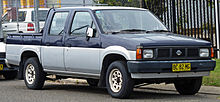

In the US, the Hardbody cab styles were 'Standard' and 'King' (also known as 'Extended'). Bed lengths were 'standard' 6-foot (2 m) and 'long' seven foot. International markets also received the 'Crew Cab' (4-door) version with a short four and a half foot bed.
4-cylinder and V6 engines were available. A 2.4 litre four-cylinder Z24i engine was used up until 1989 and produced 106 hp. In 1989, this was replaced by the KA24E of similar displacement, this being a respectable-performance SOHC engine which was installed for the 1990 through 1997 model years with a new three-valve-per-cylinder head producing 134 hp (100 kW) (being the same engine as used in the 240SX). The six-cylinder 3.0 litre VG30i (early years) or VG30E (later years) engine increased power and torque only modestly and was unavailable in the US starting with the 1996 model year because Nissan was unable to meet the requirements of the new OBD-II emissions law in time.
Five-speed, including overdrive, manual transmissions were the most common, but an automatic transmission was an available option. Both rear-wheel-drive (4x2) and four-wheel-drive (4x4) versions were made in quantity. A limited slip differential was standard on the top 'SE' trim 4WD variants.
Major options included air conditioning, larger wheels/tires, sliding rear window, stereo, and rear bumper. There were several trims available including base, XE, and top of the line SE. The XE could be ordered with a 'value package' starting in 1994 which included air conditioning, power mirrors, alloy wheels, and chrome on body trim such as the mirrors and bumpers. The SE was better equipped and could be ordered with the "sport power package" with sunroof, power windows, locks, and mirrors, air conditioning and special "Robot" alloy wheels.
In 1992, Nissan had a strange model year crossover which 1993 models had the dashboard of the 1986.5–1992 model years with a slightly refreshed body appearance as well as some small interior changes and a revised instrument panel. In a first for the auto industry, this model used the new R134A air conditioning refrigerant.
In 1993, the last major refresh would last through 1997. Changes were a new ergonomic dashboard and much improved interior for 1994.
1995 was the first model year to comply with the new US, Department of Transportation "high mount brake light" regulation requiring all trucks to have a brake light in the center of the rear at the top of the cab, though a temporary light was added to the 1994 models.
In late 1995, a driver's side airbag was added as well as compliance with the new US OBD-II emissions law. Rear wheel ABS came with both 2WD and 4WD models beginning in 1990.
Versions sold in other countries came with a host of more economical engines, ranging from 1.6-litre gasoline fours up to a 2.7-litre diesel four-cylinder, including SD25 and TD25 diesel engines.



These low-cost, dependable Hardbody small pickup trucks sold very well worldwide, and are still often seen both on-road and off-road. They are renowned for their reliability and endurance, with the exception of body panel and frame rust over time. Other things to look for are a noisy timing chain on the 1990–1997 KA24E (2.4) 4cyl engine in particular which had a problem with the stock timing chain guides and slippers deteriorating, breaking off and allowing the timing chain to damage the timing cover, seizing the chain to the engine and/or timing cover, as well as damaging pistons and bending valves requiring serious engine work in extreme cases. This was remedied by buying aftermarket engine timing parts, (particularly the chain guide, slipper and tensioner), and repairing immediately when noises became apparent. Otherwise, the KA24E was an excellent engine. The V6 engine had a timing belt that requires replacing every 60K miles. Exhaust manifold studs were well known to fail prematurely due to heat embrittlement from poor materials quality, on all years from 1986.5- 1995. In the US, beginning in 1997, the new "D22" was official named, "Frontier" and used a new DOHC 2.4 4cyl borrowed from the Nissan Altima. A newly modified "VG33" V6 was available in 1998 and ending production in the US in 2004. The new VG33E V6 had new, larger, 10 mm exhaust manifold studs in an attempt to decrease the risk of premature exhaust manifold stud failure, but still had limited success.
In general however, the VG30E and VG33E V6's were both amazingly reliable engines.
The D21 design was still available new in some Latin American countries, made in Mexico until the 2008 model year. In its current home country a range of four basic variations of the D21 are sold together as the Nissan Camiones (literally "Nissan Trucks").
Nissan Mexicana ended production of the Camiones on March 15, 2008 after 15 years of production in the Cuernavaca plant.
The Nissan D21 is still being sold in Venezuela as of 2014.[16]
References
- ^ Bent, Alan. "1959 Datsun 220 Model". Earlydatsun.com. Retrieved 27 June 2012.
- ^ a b c Bent, Alan. "1968 Datsun 521 Truck". Earlydatsun.com. Retrieved 27 June 2012.
- ^ Bent, Alan. "1968 Datsun 520 Truck". Earlydatsun.com. Retrieved 27 June 2012.
- ^ a b New Datsun Pickup 1500 (brochure), Japan: Nissan Motor Co, 1972, p. 2, L61E
- ^ Datsun One Ton Utility (brochure), New Zealand: Nissan Motor Distributors (NZ), 1975, p. 4
- ^ "自動車ガイドブック 1978/1979 [Japanese Motor Vehicles Guide Book 1978/1979]" (in Japanese). 25. Japan: Japan Automobile Manufacturers Association. 10 October 1978: 218. 0053-780025-3400.
{{cite journal}}: Cite journal requires|journal=(help) - ^ Datsun saves again in '75 (National Sales Training), 1974, p. 22
- ^ Datsun: La voiture maximum (catalog) (in French), Nissan Automobile Company (Canada) Ltd., 30 August 1975, p. 15, 99999-01099. 100M EP
{{citation}}: Unknown parameter|trans_title=ignored (|trans-title=suggested) (help) - ^ Datsun saves again in '75, p. 21
- ^ Datsun saves again in '75, p. 23
- ^ Nissan Commercial Vehicle Range 1984 (brochure), Worthing, UK: Nissan UK Limited, July 1984, pp. 5–6, S24.25m.F923.7.84
- ^ a b แกะรอยกระบะนิสสัน(3)เปิดตำนานบิ๊กเอ็ม (in Thai). Manager Online. 27 April 2007. Retrieved 2 June 2011.
- ^ http://www.zznissan.com.cn/ official Website of Zhengzhou-Nissan
- ^ http://articles.latimes.com/1986-03-23/magazine/tm-5460_1_american-cars/3
- ^ a b Datsun: ニューパワーNA20、NA16新型ガソリンエンジンシリーズ搭載 (Catalog) (in Japanese), Nissan, March 1990, p. 15, C1171-0033AGK
{{citation}}: Unknown parameter|trans_title=ignored (|trans-title=suggested) (help) - ^ http://www.nissan.net.ve/ambard2101.htm





